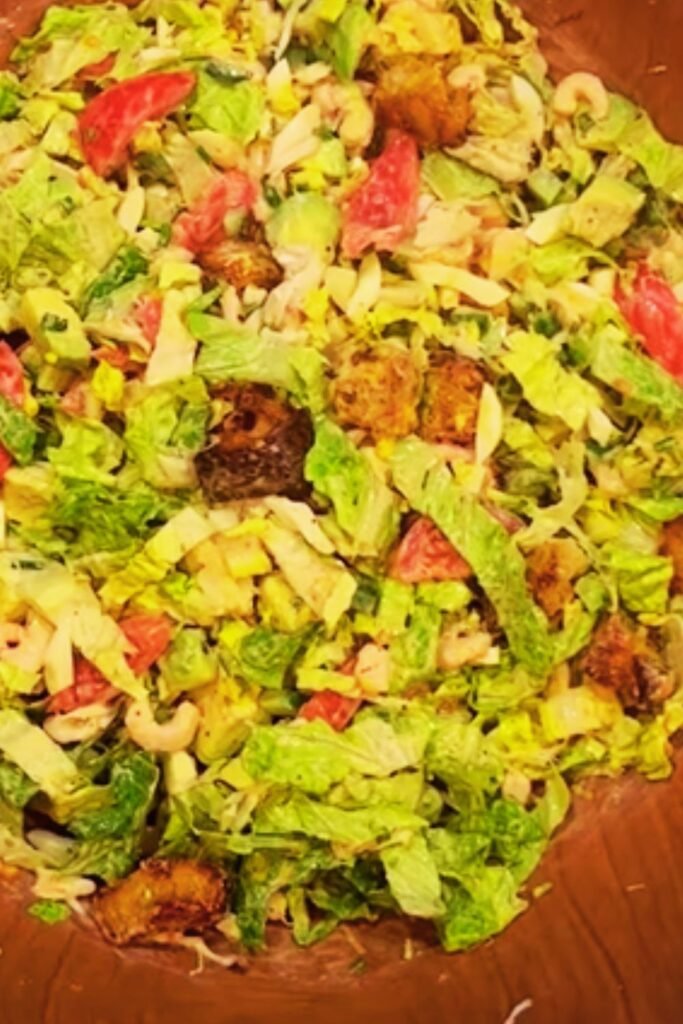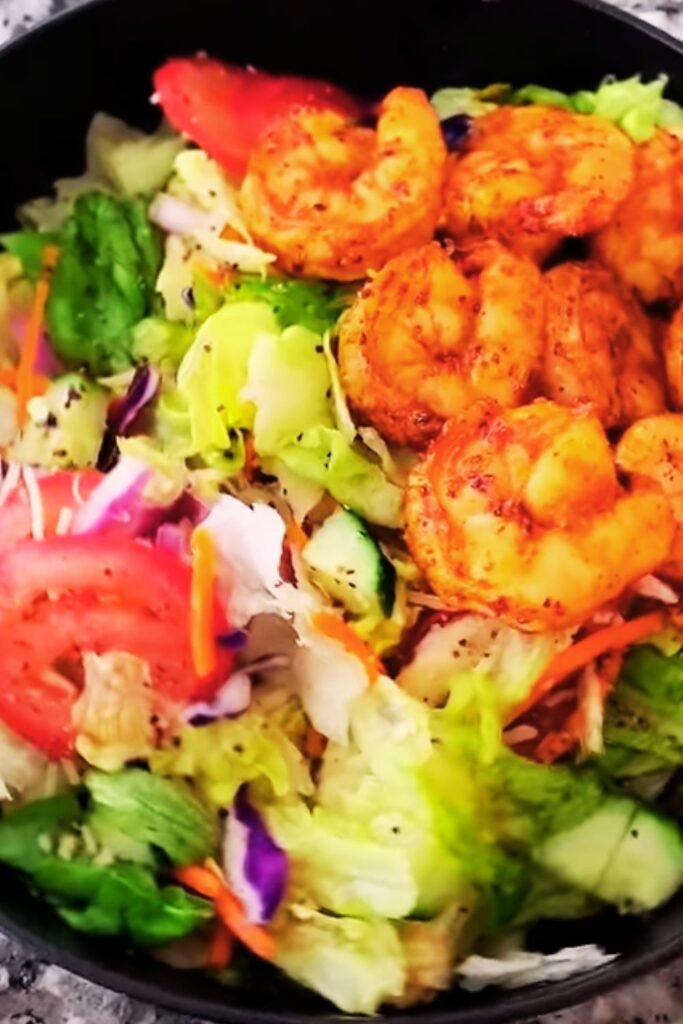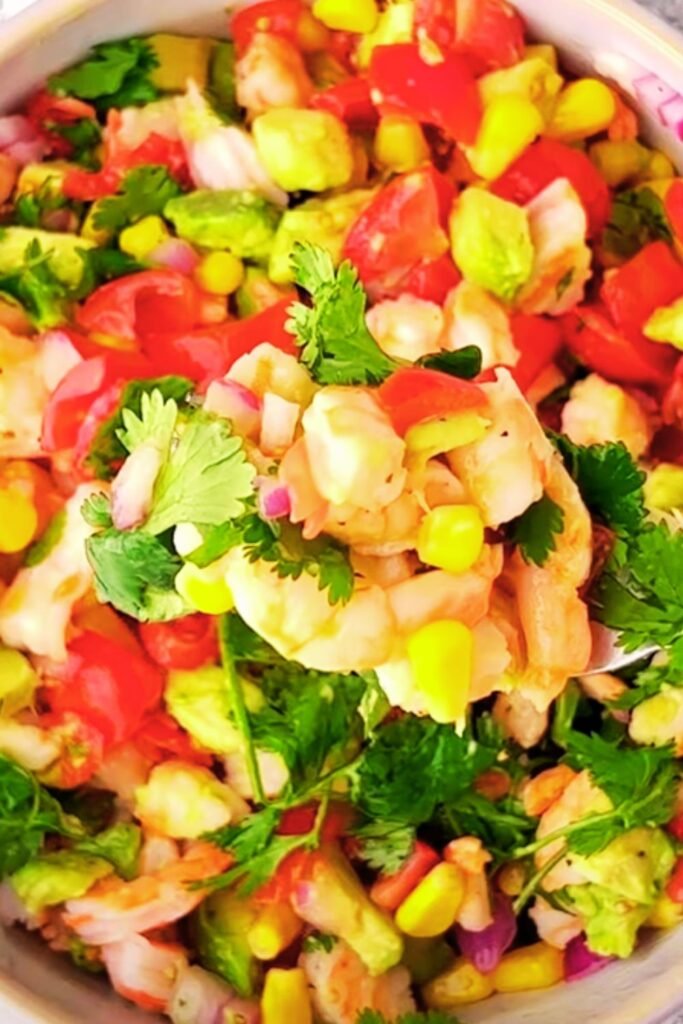I’ve been making Shrimp Louie salad for over a decade, and it never fails to impress guests at my dinner parties. This iconic West Coast creation combines perfectly cooked shrimp with crisp vegetables and a tangy Louie dressing that ties everything together beautifully. What started as a simple salad in San Francisco’s restaurants has become one of my go-to dishes when I want something elegant yet refreshing.
The beauty of Shrimp Louie lies in its simplicity and the quality of its ingredients. I love how this salad showcases fresh shrimp without overwhelming it with heavy sauces or complicated preparations. Every bite delivers a perfect balance of textures and flavors that makes it suitable for lunch, dinner, or even as an impressive appetizer for special occasions.
The Rich History Behind Shrimp Louie
When I first discovered Shrimp Louie, I was fascinated by its origins. This salad traces its roots back to early 20th century San Francisco, where it was served in upscale hotels and restaurants. The dish gained popularity during the 1920s and became a staple of West Coast dining culture.
The name “Louie” has several origin stories, though most food historians believe it was named after Louis Davenport, a prominent restaurateur in Spokane, Washington. Others claim it was created by a chef named Louis at the Palace Hotel in San Francisco. Regardless of its exact origins, I appreciate how this salad represents the fresh, seafood-focused cuisine that the Pacific Coast is known for.
What makes this salad particularly special to me is how it evolved from a simple fisherman’s lunch into an elegant restaurant dish. The original versions were much simpler, often just featuring crab or shrimp with basic vegetables. Over time, chefs refined the recipe, adding the signature Louie dressing that transforms ordinary ingredients into something extraordinary.
Essential Ingredients for Perfect Shrimp Louie
Creating an outstanding Shrimp Louie starts with selecting the right ingredients. I’ve learned through experience that quality matters significantly in this dish since each component plays a crucial role in the final result.
Fresh Shrimp Selection
The star of this salad deserves careful attention. I always choose large or extra-large shrimp, typically 16-20 count per pound. Fresh shrimp should smell like the ocean, not fishy, and feel firm to the touch. When fresh isn’t available, I opt for frozen shrimp that were flash-frozen on the boat, as these often have better quality than “fresh” shrimp that’s been sitting at the market for days.
I prefer wild-caught shrimp for their superior flavor and texture. Gulf shrimp, Pacific white shrimp, and spot prawns are my favorites. The key is avoiding shrimp that’s been pre-treated with sodium tripolyphosphate, which can make them mushy and overly salty.
Vegetable Components
The vegetables in Shrimp Louie provide essential crunch and color contrast. I use a combination of:
- Iceberg lettuce: Provides the classic crisp base
- Tomatoes: I prefer Roma or vine-ripened varieties for their firm texture
- Hard-boiled eggs: Essential for the traditional presentation
- Cucumber: English cucumbers work best for their mild flavor
- Avocado: Adds richness and California flair
- Red onion: Just a small amount for subtle bite

The Secret to Perfect Louie Dressing
The Louie dressing is what elevates this salad from ordinary to extraordinary. I’ve perfected my recipe over years of experimentation, and the key lies in balancing the tangy, creamy, and slightly spicy elements.
My dressing combines mayonnaise as the base with chili sauce (not ketchup), fresh lemon juice, and a touch of Worcestershire sauce. The chili sauce provides the signature pink color and complex flavor that sets Louie dressing apart from thousand island or Russian dressing.
Traditional Louie Dressing Recipe
Here’s my tried-and-true formula:
- 1 cup high-quality mayonnaise
- 1/4 cup chili sauce (Heinz or similar)
- 2 tablespoons fresh lemon juice
- 1 tablespoon sweet pickle relish
- 1 teaspoon Worcestershire sauce
- 1/2 teaspoon paprika
- 1/4 teaspoon garlic powder
- Salt and white pepper to taste
I whisk everything together and let it chill for at least 30 minutes before serving. This allows the flavors to meld beautifully.
Step-by-Step Preparation Guide
Creating the perfect Shrimp Louie requires attention to timing and technique. I’ve developed a systematic approach that ensures every component is at its best when the salad comes together.
Preparing the Shrimp
I start by bringing a large pot of salted water to boil. The water should taste like seawater – this seasons the shrimp from the inside out. I add a bay leaf, lemon slice, and a few peppercorns to the water for extra flavor.
When the water reaches a rolling boil, I add the shrimp and cook for exactly 2-3 minutes, depending on size. The shrimp are done when they turn pink and curl slightly. I immediately transfer them to an ice bath to stop the cooking process and preserve their tender texture.
Once cooled, I peel the shrimp, leaving the tails on for presentation if desired. I devein them carefully and pat them dry with paper towels. Properly cooked shrimp should be firm but not rubbery, with a sweet, clean flavor.
Preparing the Vegetables
I wash and dry all vegetables thoroughly. For the lettuce, I tear it into bite-sized pieces rather than cutting it, which prevents browning and maintains better texture. The tomatoes get cut into wedges, and I remove the seeds to prevent the salad from becoming watery.
Hard-boiled eggs are crucial for authentic Shrimp Louie. I use the cold-start method: placing eggs in cold water, bringing to a boil, then cooking for exactly 10 minutes. After cooking, I plunge them into ice water and let them cool completely before peeling.

Assembly and Presentation Techniques
The presentation of Shrimp Louie is almost as important as the taste. I follow the traditional plating style that showcases each component beautifully.
I start with a chilled plate and create a bed of lettuce leaves. Then I arrange the shrimp in a circular pattern around the plate, typically 6-8 pieces per serving. The hard-boiled eggs get quartered and placed strategically around the shrimp.
Tomato wedges, cucumber slices, and avocado pieces fill in the spaces, creating a colorful, balanced presentation. I save a few perfect shrimp for the center of the plate as a focal point.
The dressing gets served on the side in a small ramekin, allowing diners to control the amount they use. I also provide lemon wedges for those who prefer extra acidity.
Nutritional Profile and Health Benefits
| Nutrient | Amount per Serving | % Daily Value |
|---|---|---|
| Calories | 285 | 14% |
| Protein | 24g | 48% |
| Carbohydrates | 8g | 3% |
| Dietary Fiber | 3g | 12% |
| Total Fat | 18g | 28% |
| Saturated Fat | 3g | 15% |
| Cholesterol | 185mg | 62% |
| Sodium | 520mg | 22% |
| Vitamin C | 25mg | 28% |
| Vitamin A | 850 IU | 17% |
| Iron | 2.8mg | 16% |
| Calcium | 95mg | 9% |
Shrimp Louie offers impressive nutritional benefits. The shrimp provides high-quality protein with all essential amino acids, while being relatively low in calories. Shrimp is also rich in selenium, vitamin B12, and omega-3 fatty acids.
The vegetables contribute important vitamins, minerals, and antioxidants. Tomatoes provide lycopene, avocados offer healthy monounsaturated fats, and the lettuce adds folate and vitamin K.
Variations and Modern Adaptations
Over the years, I’ve experimented with various adaptations of the classic recipe. While I respect the traditional version, these variations can add exciting new dimensions to the dish.
Crab Louie Variation
Sometimes I substitute Dungeness crab for shrimp, creating the equally classic Crab Louie. The preparation remains identical, but the crab adds a different texture and slightly sweeter flavor profile.
Lightened Version
For health-conscious diners, I create a lighter version using Greek yogurt-based dressing. I replace half the mayonnaise with plain Greek yogurt and add extra lemon juice and herbs. The result is tangier but still delicious.
Spicy Modern Twist
I occasionally add jalapeño to the dressing or include sliced radishes for extra heat and crunch. A few drops of hot sauce can also enhance the traditional dressing without overwhelming the delicate shrimp.

Wine and Beverage Pairings
The right beverage can elevate Shrimp Louie from good to extraordinary. I’ve found that certain pairings complement the salad’s flavors beautifully.
Crisp white wines work exceptionally well with this dish. Sauvignon Blanc’s acidity cuts through the richness of the dressing while highlighting the shrimp’s sweetness. Pinot Grigio offers a lighter option that won’t compete with the delicate flavors.
For non-alcoholic options, I recommend sparkling water with lemon, iced tea, or fresh lemonade. These beverages cleanse the palate between bites and enhance the overall dining experience.
Storage and Make-Ahead Tips
| Component | Storage Method | Duration | Notes |
|---|---|---|---|
| Cooked Shrimp | Refrigerated, covered | 2-3 days | Pat dry before storing |
| Louie Dressing | Refrigerated, airtight | 1 week | Stir before using |
| Hard-boiled Eggs | Refrigerated, unpeeled | 1 week | Peel just before serving |
| Prepared Vegetables | Refrigerated, separate containers | 2-3 days | Keep tomatoes separate |
| Assembled Salad | Not recommended | Serve immediately | Components become soggy |
I often prepare components ahead of time for entertaining. The shrimp can be cooked and chilled up to two days in advance. The dressing actually improves in flavor after sitting overnight in the refrigerator.
However, I never assemble the complete salad until ready to serve. The lettuce wilts quickly, and the tomatoes release juice that can make everything soggy.
Troubleshooting Common Issues
Through years of making this salad, I’ve encountered and solved various problems that can arise during preparation.
Overcooked Shrimp
If shrimp become rubbery, they’ve been overcooked. I watch them carefully and remove them from the heat the moment they turn pink and curl. The residual heat continues cooking them slightly even after removal from the water.
Watery Salad
This usually results from not properly draining vegetables or using overly ripe tomatoes. I always pat everything dry and seed the tomatoes before adding them to the salad.
Bland Dressing
If the dressing lacks flavor, I add more lemon juice, a pinch of salt, or a dash of hot sauce. Tasting and adjusting seasonings is crucial for the perfect balance.
Seasonal Considerations and Sourcing
The best time to make Shrimp Louie depends on your location and ingredient availability. I prefer making it during summer when tomatoes are at their peak and local shrimp are in season.
In coastal areas, I source shrimp directly from local fishermen or reputable seafood markets. The fresher the shrimp, the better the final result. During off-season, I choose high-quality frozen shrimp and thaw them properly in the refrigerator.
For the best tomatoes, I visit farmers’ markets during peak season or grow my own. The difference in flavor between a perfect vine-ripened tomato and a grocery store variety is remarkable in this salad.
Cost Analysis and Budget-Friendly Tips
| Ingredient | Cost per Serving | Budget Alternative |
|---|---|---|
| Large Shrimp (6 oz) | $4.50 | Medium shrimp or sale prices |
| Vegetables | $1.25 | Seasonal selections |
| Eggs | $0.50 | Buy in bulk |
| Dressing Ingredients | $0.75 | Make large batches |
| Total per Serving | $7.00 | $5.50 with alternatives |
To reduce costs, I buy shrimp in bulk when on sale and freeze portions. I also grow my own lettuce and tomatoes during summer months, which significantly reduces the per-serving cost.
Professional Chef Tips
My experience has taught me several professional techniques that elevate home-cooked Shrimp Louie to restaurant quality.
First, I always chill the plates before serving. This keeps the salad crisp longer and shows attention to detail. Second, I taste each component separately before assembly to ensure optimal seasoning.
The shrimp should be at the perfect temperature – cool but not ice-cold. I remove them from the refrigerator 15 minutes before serving to take the chill off.
Finally, I present the salad immediately after assembly. The longer it sits, the more the textures deteriorate and flavors muddle together.
Cultural Significance and Regional Variations
Shrimp Louie represents an important piece of American culinary history, particularly in the Pacific Northwest and California. It embodies the region’s focus on fresh seafood and simple preparations that highlight natural flavors.
Different regions have their own variations. In some areas, crab is preferred over shrimp. Others add different vegetables or modify the dressing recipe. These regional differences reflect local tastes and available ingredients.
I appreciate how this salad bridges casual and fine dining. It’s elegant enough for special occasions but approachable enough for everyday meals.
Questions and Answers
Q: How far in advance can I prepare Shrimp Louie? I recommend preparing components up to 2 days ahead but assembling only when ready to serve. The shrimp, dressing, and hard-boiled eggs can be made in advance, but the vegetables should be prepared the day of serving for best quality.
Q: Can I use frozen shrimp for this recipe? Absolutely! I often use high-quality frozen shrimp that’s been properly thawed in the refrigerator. Choose shrimp that’s flash-frozen and avoid those with added sodium solutions. The key is proper thawing and not overcooking.
Q: What’s the difference between Louie dressing and Thousand Island? Louie dressing uses chili sauce instead of ketchup and typically includes Worcestershire sauce. It has a more complex flavor profile and is less sweet than Thousand Island dressing. The texture is also slightly different due to the chili sauce.
Q: Can I make this salad vegetarian? While it wouldn’t be traditional Shrimp Louie, you could substitute the shrimp with hearts of palm, avocado, or even marinated artichoke hearts. The dressing and vegetables would remain the same, creating a delicious vegetarian salad.
Q: How do I prevent the avocado from browning? I add the avocado just before serving and toss it lightly with lemon juice. This prevents browning and adds a nice citrus note. If preparing ahead, I store avocado separately and add it at the last minute.
Q: What size shrimp works best for this salad? I prefer large shrimp (16-20 count per pound) because they provide substantial pieces that balance well with the other ingredients. Smaller shrimp can get lost in the salad, while jumbo shrimp might be too overwhelming.
Q: Can I substitute the mayonnaise in the dressing? For a lighter version, I sometimes use half Greek yogurt and half mayonnaise. Avocado-based mayonnaise also works well. However, traditional mayonnaise provides the best flavor and texture for authentic Louie dressing.
Q: How do I know when the shrimp are perfectly cooked? Shrimp are done when they turn pink and curl into a C-shape. They should be firm but not rubbery. Overcooked shrimp will curl into tight circles and have a tough texture. The cooking time is typically 2-3 minutes for large shrimp.
Q: What’s the best way to store leftover dressing? I store Louie dressing in an airtight container in the refrigerator for up to one week. Before using, I stir it well as the ingredients may separate. The flavor actually improves after sitting for a day.
Q: Can I use this dressing for other salads? Definitely! Louie dressing is excellent on other seafood salads, as a dip for vegetables, or even as a sandwich spread. It pairs particularly well with crab cakes or fried seafood.